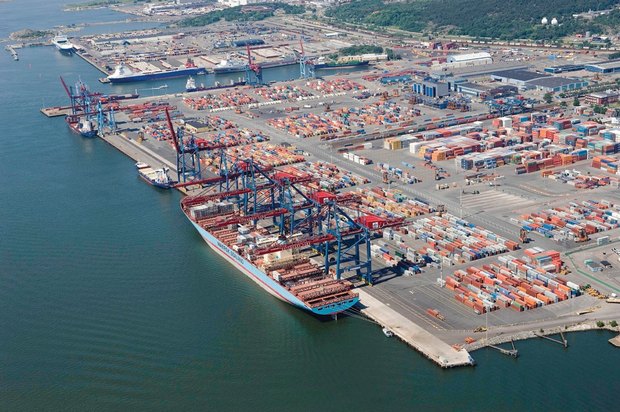
Container-terminal at the Port of Gothenburg. Photo provided by Gothenburg Port Authority
Anybody planning for future transport should then be aware of the centrality of containers. They are growing in importance all the time and they are growing fast. According to the Port Authority of Gothenburg, there were 4 million containers-shifts or throughputs as they are called in the trade, in what they call the Scandinavian and Baltic container market, in 2001.
Already, by 2007, this figure had growth to 8 million. Now expectations are that it will increase to 15 million by 2015. That is a continuous growth of some ten percent year on year.
The largest container-harbour in the Scandinavian-Baltic area is St. Petersburg with a throughput last year of close to 1.7 million containers. The number of container-ships is constantly increasing and is a matter of some frustration to crews on the many ferries sailing in the Gulf of Finland. – You know, these vessels are not like us, they do not sail at regular hours, so we always have to be on extra look-out for them, they explain.
The Port of Scandinavia?
Container-port number two in this part of the world is Gothenburg. Last year this harbour on the Swedish west-coast, had a throughput of 841 000. – The number of containers coming in is approximately the same as the number going out, just above 400 000, says Kristina Weber at the Gothenburg Port Authority. In terms of containers, the Port of Århus in Denmark is number three with 504 000 throughputs.
The large majority, more than 95 percent of all containers arriving at, or leaving, the Port of Gothenburg come by rail or road. – In fact, less than five percent continue on by ship, explains Kristina Weber.
The Port of Scandinavia is what the harbour of Gothenburg calls itself. Gothenburg is the only port in the Nordic countries with trans-oceanic calls from the Far East and North America, they claim. Furthermore they say that 70 percent of Nordic industrial production is located within a 500 km radius of the city, and that all of that can be reached within six hours. For that to be true, transport has to move at an average speed of 83 km/hour.
More containers by train
From 2001 to 2007 the total number of containers coming in-or-out of the hub of Gothenburg, as the port also is called, grew from 595 000 to 841 000. While road-haulage was booming for many years, it is now train-traffic which dominates. The number of containers going by rail has grown from 118 271 to 322 210, that is more than a 100% increase. In percentage terms the equivalent overall growth rate saw an increase from 20 to 38%.
– Both ourselves and our customers want to use rail, mostly for environmental reasons, explains Eric Nilsson vice-president of the Gothenburg Port Authority. Although there is a lot of discussion in Sweden about whether it is possible to increase transport numbers by rail, Eric Nilsson still sees further possibilities: – It is difficult to say by how much, and there undoubtedly are major bottlenecks, single-line tracks and cross-overs only 350 meters long, while many goods-trains are double that length. Nevertheless, we have managed to expand by 10-15% every year and hope we can continue.
In 2004 The Danish Centre of Architecture (DAC) presented a proposal by PLOT-architect to build an artificial island between Denmark and Germany. The island would be one element in the construction of new Fehmern-brigde, the direct link between Copenhagen and Hamburg, and would encompass a harbour to cater for up to 300 million people in Northern Europe. – I understand the idea, but I cannot say that the location is the best, considering all the large ships that would have to go through Øresund, comments Eric Nilsson.
One billion throughputs
For all the ports of the world it is estimated that containers were moved some 450 million times last year. The estimate is also that each container was shifted 3.2 times during this period. In other words, some 120 million containers were shifted through the world's harbours. In addition there are many containers which are not transferred in and out of ports, which might never see the oceans at all. They spend their time on rail/rail, road/road or road/rail. In total therefore, the actual number of containers, globally, could be as high as 200 million and the number of throughputs could top one billion, or even more.
It is harbours like Shanghai, Singapore, Hong Kong and Shenzhen, which are the new kingdoms of the container. They each handle more than 20 million throughputs every year. Singapore, at the top of the pile, saw close to 28 million for 2007.
The final figures are provided by the Port of Rotterdam. In terms of handled tonnages this is the third largest harbour in the world. In terms of containers, it is number six. In total, 5.6 million containers came through this harbour and almost the same number, 5.3 million, went out. That gives a throughput close to 11 million.
Hamburg is the other really large container-port in Europe. Measured by throughputs it is number nine in the world. In total the number of containers going through the German harbour port was close to 10 million last year.
Both Rotterdam and Hamburg are major harbours for transhipment to the Nordic and Baltic harbours. That means the containers are forwarded by a new and usually smaller ship and not by train or lorry.
– Although we have the capacity to receive them, the really big container-ships do not regularly call at our ports, explains Eric Nilsson vice-president of Goteborg Port Authority. – Usually it is only some sections of the cargo which ends up in our markets. Therefore the total cost of transport becomes lower, if the containers are moved to smaller vessels for the final legs, he adds.
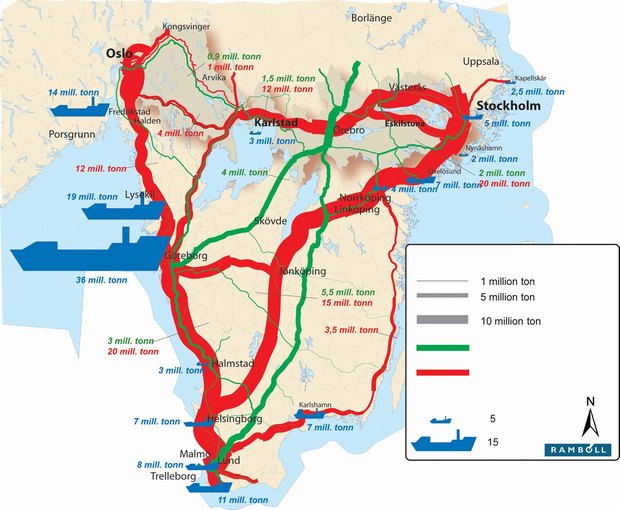
Flow of goods by sea, road and rail in the Triangle Figure provided by Rambøll. Click to view larger image.
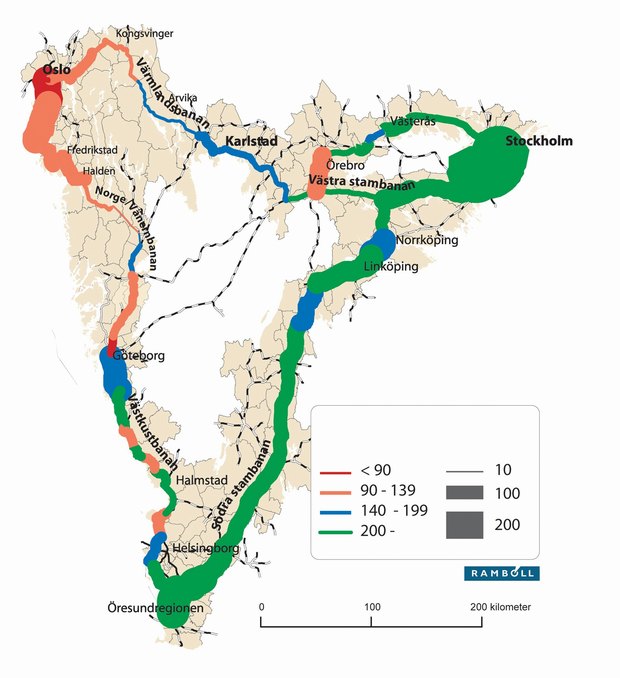
Frequency and standard for rail travel in the Triangle Figure provided by Rambøll. Click to view larger image.
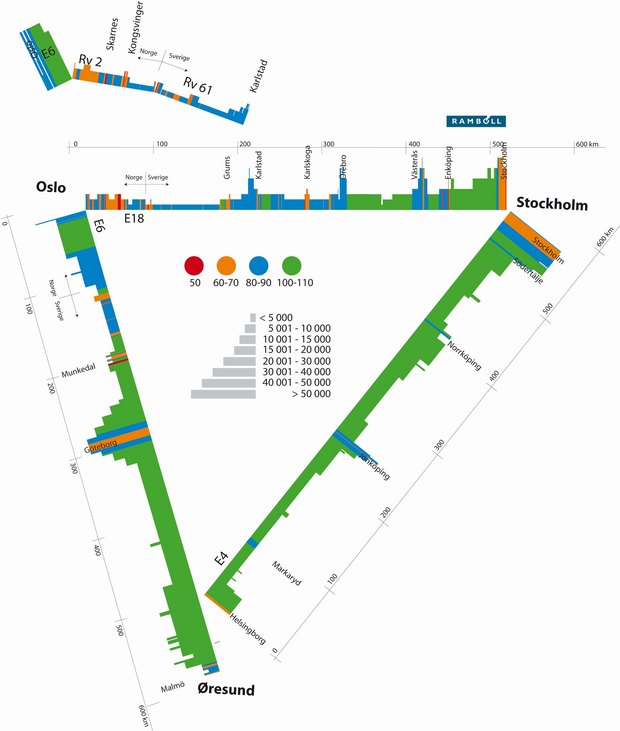
Road-traffic flow in the Triangle Figure provided by Rambøll. Click to view larger image.
The Nordic Triangle
The Nordic Triangle is one of the elements in the TEN-T (see pp 16-17). Recent experiences show that the leg from Gothenburg to the region of Øresund has seen constant growth. To some extent this can be explained by the provision of improved transport-structures.
The leg of the triangle often referred to as the 'Growth Corridor Oslo – Karlstad – Stockholm' aims to achieve a similar result. Both rail and road connections are however of a relatively low standard between Oslo and Karlstad. The plan is thus to change the tradition where Sweden turns eastward while Norway tends to look more to the west, in terms of economic development.
At present, daily border commuting between Sweden and Norway includes some 18 000 persons, well above the 14 000 daily crossing Øresund. Almost half of the commuters between Sweden and Norway cross at Svinesund.
In recent years significant investment has gone into the Swedish railway system. Trains between Stockholm and Malmö now take two hours less than they did 20 years ago. For Oslo – Stockholm however the travel time is the same today as in the 1980s.
By Odd Iglebaek

Figures provided by Gothenburg Port Authority.
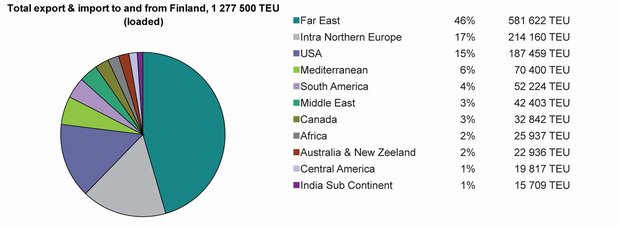

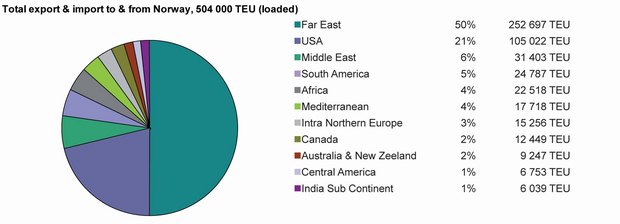
One TEU is equivalent to one twenty foot long container and all containers are calculated in this unit to provide international comparisons. Diagrams and figures above provided by Gothenburg Port Authority.